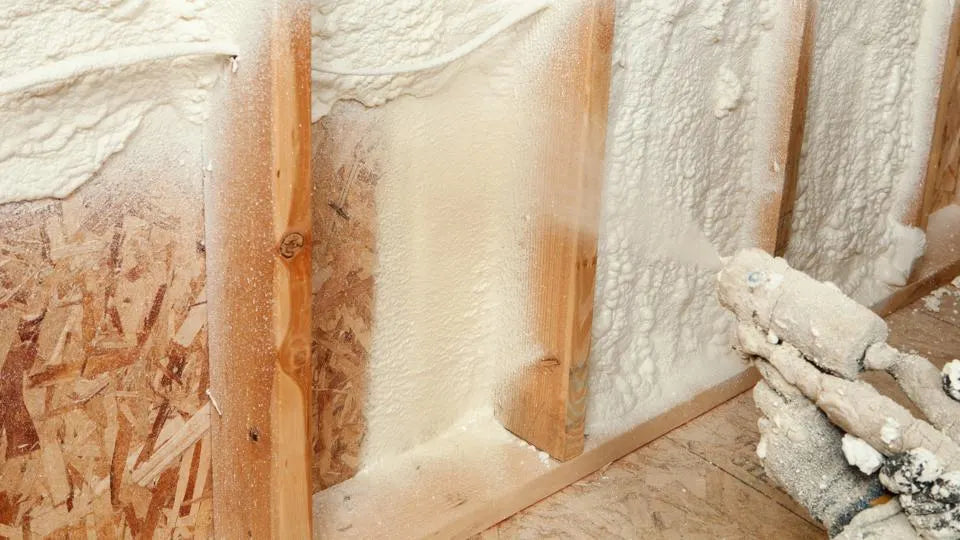Best Spray Foam Insulation for DIY Projects
Thinking about a DIY project that needs insulation? DIY Spray foam could be perfect for you. It’s great at keeping your home warm or cool. And it seals the air well, which many homeowners love.
But there are many types to pick from. How do you choose the best spray foam for your project? You’re looking for one that’s both good quality and not too expensive.
We’re here to help. This article will look at top spray foam products for DIY. We’ll talk about what makes them great. This will help you choose the right one for your home project.

Key Takeaways
- Choosing the right spray foam insulation is crucial for a successful DIY project.
- Spray foam insulation provides excellent thermal insulation and air sealing.
- Consider factors like affordability, quality, and ease of installation when selecting a spray foam insulation product.
- Look for top-rated DIY spray foam insulation kits for an efficient and effective insulation process.
- Consulting professionals or experts can help you make the right decision for your specific project.
Choosing the Right Spray Foam Insulation for DIY
Choosing the right insulation for your DIY is key to a successful project. You'll find many types of spray foam insulation out there. Knowing what to look for can help you pick the best one. We'll help you understand how to choose the perfect spray foam for your project.
Read More: What is the best DIY spray foam insulation?
Factors to Consider
When picking spray foam for DIY, think about these factors:
- R-Value: R-value shows how well insulation keeps heat in or out. A higher R-value means better insulation. Think about your climate and how much you want to save on energy.
- Application Method: There's spray foam and foam-in-place insulation. Spray is great for big areas and tight spots. Foam-in-place is for detailed work. Choose what fits your project best.
- Budget: Work out your budget and find an insulation type that matches. Remember, spending more on insulation can save you money on energy costs in the long run.
Types of Spray Foam Insulation
Spray foam comes in two main types:
- Open-cell foam: Lighter and great for stopping sound and sealing air. It is more flexible. Plus, it’s usually cheaper.
-
Closed-cell foam: Denser, with a better R-value per inch. It’s stronger against moisture and stays firm. It’s pricier, but it works well in different weather conditions.

Now, you're equipped to choose the best spray foam for your project. Look at the R-value, how it's applied, and your budget. This will help you reach your insulation and energy goals.
Read More: Closed Cell vs Open Cell Foam
Easy DIY Installation Tips for Spray Foam Insulation
This section will guide you through DIY installation of spray foam insulation. It's great for attics, basements, or walls. You'll learn steps to get pro results.
Gather Your Materials
First, gather all you need. This includes:
- Spray foam insulation kit
- Protective clothing (gloves, goggles, and a mask)
- Utility knife
- Measuring tape
- Caulking gun
- Drop cloths or plastic sheeting
Prepare the Area
Prepping right is crucial for a good installation. Here's what to do:
- Clean the area well to remove dust and debris.
- Seal any gaps with caulk or foam sealant.
- Protect nearby stuff with drop cloths or plastic.
- Turn off HVAC systems to avoid issues from the insulation.
Apply Spray Foam Insulation
Now, let's start with the spray foam. Follow these steps:
- Shake the canister to mix the foam components well.
- Start spraying at the bottom, moving up in a thin, even layer.
- Focus on gaps and tight spots with a narrow nozzle or extension.
- Layer the foam for the right thickness, keeping it even.
Post-Installation Tips
After installing, remember these tips:
- Let the insulation fully cure and expand before touching it.
- Trim away any extra foam carefully with a utility knife if there's too much.
- Check the insulation regularly for damage and fix problems fast.
With the right tips, installing spray foam insulation can be easy. But remember, complex or big jobs might need a pro's help.
Read More: Top DIY Spray Foam Insulation Tips & Tricks

|
Pros of DIY Spray Foam Insulation Installation |
Cons of DIY Spray Foam Insulation Installation |
|
Cost savings compared to hiring a professional |
Potential for inadequate installation if not done correctly |
|
Flexibility to work at your own pace |
Higher risk of exposure to chemicals if proper safety precautions are not taken |
|
Opportunity to learn new skills and gain hands-on experience |
Potential for voids or gaps in the insulation if not applied evenly |
|
Ability to address small-scale insulation projects |
Time-consuming and labor-intensive process |
Read More: Spray foam insulation pros and cons
Top-Rated Spray Foam Insulation Kits for DIY
Planning to tackle a spray foam project on your own? Choosing the right kit is key. We've looked into top kits for DIY work. They are convenient, easy to use, and offer great insulation. Keep reading to discover the best spray foam kit for you.
Vega Bond V600 Spray Foam Insulation Kit
The Vega Bond V600 Component is highly rated for DIY. It comes complete for easy installation. With high-quality foam, it fills gaps well. This means better insulation and fewer drafts. It’s simple to use and yields pro-level results.
Vega Bond V200 Spray Foam Insulation Kit
Need something quick and efficient? The Vega bond V200 is a smart pick. It’s made for DIYers and dries fast. This ensures top-notch thermal insulation and keeps your home cozy. Plus, it fights off moisture for a snug living space.
Vega Bond Purplecoat Single Component Foam Sealant Kit
For smaller jobs, the Purplecoat Single Component Kit is a great choice. It’s perfect for sealing small openings. With fast expansion and easy use, it gives a smooth finish. Its formula lasts long, guaranteeing solid insulation.
Conclusion
Spray foam insulation is great for DIY projects at home. It makes your house better by using less energy, reducing sound, and making it more cozy inside. With the right type, DIYers save money on heating and cooling their homes over time. This also helps the environment a lot.
When you pick spray foam for your project, think about its good and bad sides. It's fantastic at its job but needs careful handling and safety gear. Always use advice from experts, like VB Insulation, for the best results.
VB Insulation has everything for DIY fans. They have kits with clear instructions and all the tools you need. Choosing their products means a cozier, more energy-efficient home for you.
For harder jobs or if you'd rather not DIY, getting a professional might be smarter. They know what they're doing and have special tools. But if you're good at DIY and want something that works, try VB Insulation's spray foam.
Read More: Spray Foam Cost Per Square Foot
FAQ
What is spray foam insulation?
Spray foam insulation is a kind of material. You spray it into walls, ceilings, and more in buildings. It stops air from getting in. It also keeps heat from going out. This material expands when you use it, filling in any gaps or cracks.
Why should I consider using spray foam insulation for my DIY project?
It's a good idea for DIY projects because it offers many benefits. This foam keeps your home warm, which reduces how much you spend on energy. It makes the air quality inside better and cuts down on noise from outside. Plus, it's strong and not hard to put in if you're careful.
How do I choose the right spray foam insulation for my DIY project?
First, think about how much insulation you need (the R-value), how you'll apply it, and what you can spend. You can pick from open-cell or closed-cell foam, each for different uses. Doing your homework on these choices can help you choose well.
Can I install spray foam insulation myself, or should I hire a professional?
You can do it yourself but you must be very careful. Always follow the instructions and wear the right safety gear. For big or tricky projects, getting a pro is a good idea. They know best how to do it right.
Are there any tips or tricks for DIY installation of spray foam insulation?
Absolutely, here are some helpful tips: 1. Before you start spraying, clean and seal the area well. 2. Make sure you have the right equipment and that you mix the foam correctly. 3. Try a small area first to see the results before you do more. 4. Always work in a place with good airflow. Don't forget to protect yourself with gloves and a mask. 5. After it dries, cut off any extra foam to make it look nice.




